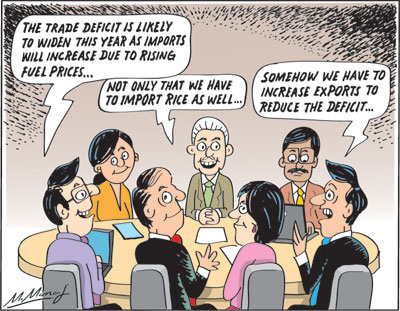Columns
Trade and balance of payments prospects in 2021
View(s): This year’s outcome in the trade balance is of paramount importance for the country’s balance of payments and external finances. A large trade deficit will increase the balance of payments deficit and deplete foreign reserves.
This year’s outcome in the trade balance is of paramount importance for the country’s balance of payments and external finances. A large trade deficit will increase the balance of payments deficit and deplete foreign reserves.
In contrast to last year, the trade deficit is likely to widen this year owing to higher import expenditure for fuel, food and raw materials.
Last year’s trade deficit
Last Sunday’s column pointed out that one of the important economic achievements of last year was the substantial reduction of the trade deficit to about US$ six billion. This trade deficit is significantly lower than the trade deficits for the three previous years when they were: US$ 9.6 billion in 2017, US$ 10.3 billion in 2018 and US$ 8.3 billion in 2019.
Decreased imports
The reduction of the trade deficit by about US$ 2.3 billion in 2020 was achieved by a sharp decrease in imports. Imports decreased by about 20 percent in the eleven months of 2020. Although exports too decreased by 16.7 percent, the reduction in imports by US$ 2.6 billion was higher.
Reduced imports
There was a 24 percent lower trade deficit in the first 11 months of last year than in the same period in 2019: US$ 5.4 billion compared to US$ 7.2 billion in 11 months of 2019.
This significant reduction in the trade deficit by US$ 1.8 billion was brought about by a decrease in imports by 20 percent from US$ 18.1 billion in the 11 months of 2019 to US$ 14.5 billion in the 11 months of 2020.
 Main reasons
Main reasons
The main reasons for this decrease was the reduction in import expenditure on oil due to decreased international oil prices and reduced domestic demand and import restrictions on what was considered non-essential items such as motor vehicles. This decrease in imports was more than the decrease in exports by 16.7 percent from US$ 18.1 billion to US$ 14.5 billion.
The reduction of the trade deficit to around US$ six billion compared to the much higher trade deficits of 2018 and 2019 was a boon to the balance of payments of 2020 that has been adversely affected by a sharp decrease in tourist earnings and capital outflows.
Trade deficit in 2021
In contrast to last year, the trade deficit is expected to widen this year owing to higher import expenditure. Increasing international prices of oil, higher rice imports and increases in intermediate import expenditure, such as on fertiliser and raw materials for manufactures, are likely to increase import expenditure to much more than that of last year. This year’s imports are likely to be around US$ 16 billion compared to about US$ 14.5 billion in 2020.
Unfavourable performance
This year’s trade performance is likely to be unfavourable due to increased import expenditure. Several global and domestic developments are unfavourable for the trade balance this year. Import expenditure is likely to rise, while export earnings are unlikely to increase to offset the increase in imports. Consequently, the trade gap will widen.
Import expenditure
Import expenditure on fuel, food and intermediate imports for manufactures would increases owing to a rise in prices of fuel, and increased imports of rice, wheat grain and intermediate imports due to higher imports of raw materials for industry. A shortfall in coconut and maize production would require imports of these too. In fact, cabinet has approved the import of a limited amount of coconut kernel already. Pest damage of vast extents of maize cultivation necessitates maize imports too. These imports would increase import expenditure this year.
Changing trade
The gradual revival of economies the world over is changing global trading conditions. The increasing trend in oil process is one of these changes that will have an adverse impact on our trade balance.
Oil imports
Rising international fuel prices will increase import expenditure substantially. In a normal year oil imports constitute about 15 percent of the country’s imports. Even if consumption of fuel does not increase this year, the increase in oil price will enhance the cost of imports.
Oil prices
Oil prices that were about US$ 30 to 32 per barrel on average, rose to US$ 52 by the end of last year and increased further to US$ 55 per barrel last week. The current increases in oil prices are not due to increased demand. It is due to a curtailment of oil production by OPEC plus. The expectation is that there would be an escalation of oil prices later this year owing to both increasing international demand and actions of oil producing countries. This is a serious blow to the country’s trade balance as import expenditure would increase substantially. Fertiliser prices too would increase in tandem with fuel prices.
Other imports
There are reasons to expect increases in other imports as well. The maha 20/21 harvest that is about to be harvested is expected to be much lower than that of last year. Paddy production is expected to fall substantially.
The Department of Census and Statistics expects this year’s maha 2020/21 crop to decrease to 2.8 million metric tons from 3.5 metric tons in ,aha 2019/20. However this estimate does not take into account the flood and climate related damage to the rice fields of the North, North Central and Eastern provinces that will make a huge dent in the country’s paddy output. It is likely to be much less than the earlier estimate of 2.8 metric tons. This shortfall in paddy production would necessitate substantial rice imports. The maize crop too is affected by pests. These developments imply a much higher import expenditure.
Prospects in 2021
In contrast to last year’s trade deficit due to primarily a reduction of imports, this year’s trade balance could be affected by an upsurge in imports such as rice, wheat grain, maize, sugar and fertiliser in addition to oil.
Exports
Only an increase in exports could help in preventing a deterioration in the trade balance this year. Hopefully exports would increase to about US$ 12.5 to 13 billion owing to increased exports due to the gradual improvement of demand for the country’s normal exports and continued demand for PPE items as COVID-19 is still spreading.
However, in the last quarter of 2020, industrial exports fell due to disruption of production in several areas owing to the spread of the pandemic. Unfortunately the further spreading of COVID-19 in key areas could affect export manufactures.
Agricultural exports too are faring badly. Tea exports have decreased in recent months and sea food imports that were expected to increase have also decreased. It is difficult to expect a significant increase in agricultural exports this year.
Export prospects
The prospects for increased exports are bleak at present. Hopefully there would be an upsurge towards the middle of the year that would narrow the trade deficit.
Conclusion
The 2021 trade deficit is likely to widen as the decrease in imports of last year is likely to be reversed this year. Import expenditure is likely to increase substantially owing to increased import expenditure on oil, rice, food imports, fertiliser and other raw materials. Hopefully the decrease of exports at the end of last year would be arrested and there would be an upsurge in exports.



Leave a Reply
Post Comment